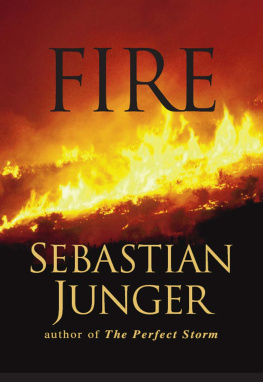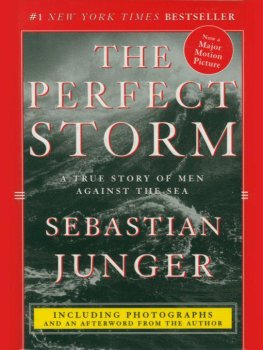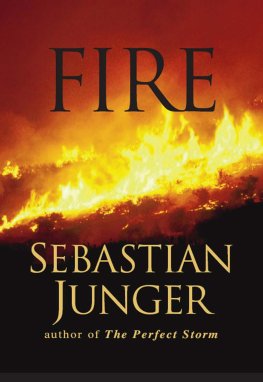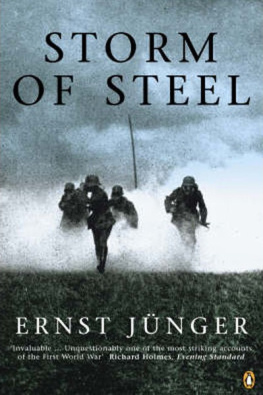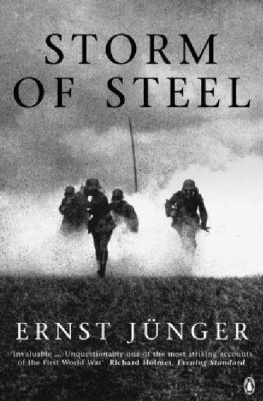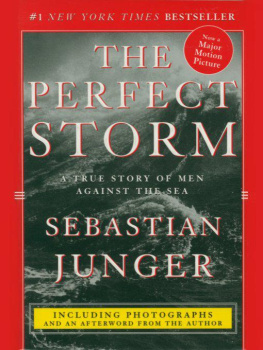FIRE
SEBASTIAN JUNGER
W. W. NORTON & COMPANY
NEW YORK LONDON

Copyright 2001 by Sebastian Junger
All rights reserved
Grateful acknowledgment is made to the following publications, where many of the pieces in this book originally appeared, in slightly different form:
Harpers: Dispatches from a Dead War, August 1999
Mens Journal: Line of Fire, October 1993; Blow Up, November 1994; Escape from Kashmir,
April 1997
National Geographic Adventure: Colters Way, Spring 1999; The Lion in Winter, March/April 2001 Outside: The Whale Hunters, October 1995
Vanity Fair: Kosovos Valley of Death, July 1998; The Forensics of War, October 1999; The Terror
of Sierra Leone, August 2000
The portions of Dispatches from a Dead War written by Scott Anderson are reprinted by permission of International Creative Management, Inc. Copyright 1999 by Scott Anderson.
Editors Note to Dispatches from a Dead War Copyright 1999 by Harpers Magazine. All rights reserved. Reproduced from the August issue by special permission.
For information about permission to reproduce selections from this book, write to Permissions,
W. W. Norton & Company, Inc., 500 Fifth Avenue, New York, NY 10110
ISBN: 978-0-393-07705-6 (e-book)
W. W. Norton & Company, Inc., 500 Fifth Avenue, New York, N.Y. 10110
www.wwnorton.com
W. W. Norton & Company Ltd., Castle House, 75/76 Wells Street, London W1T 3QT
This book is dedicated to
Ellis Settle, 19241993
Contents
Introduction
I n 1989, when I was in my late twenties, I saw a magazine photo of half a dozen forest fire fighters taking a break on the fire line. They wore yellow Nomex shirts and hard hats and had line packs on their backs and were leaning on their tools in a little meadow, watching the forest burn. In front of them was a wall of flame three hundred feet high. There was something about the men in that phototheir awe, their exhaustion, their sense of purposethat I wanted in my life. I tacked the photo to my wall and lived with it for a whole winter.
It was an uninspiring time in my life. I was living in a grim little apartment in Somerville, Massachusetts, Id quit waiting tables, and I had vague ideas of making my living as a writer. The only good thing I had going on was an intermittent jobmore of an apprenticeship, reallyworking as a climber for a tree company. Id met a guy in a bar who showed me an enormous scar across his knee from a chain saw accident, and offered me a job. He said hed teach me to climb if I worked for him whenever he needed someone. I agreed. I climbed trees over houses, trees over garages, trees over telephone lines. I climbed trees that were twenty feet high and swayed from my weight; I climbed others that were 150 years old and had branches so big that holding them was like hanging from the neck of an elephant. Some of the trees had to be taken down; some just had to be pruned. All of them terrified me. I learned to work without looking down. I learned to work without thinking too directly about what I was doing. I learned just to do something regardless of how I felt about it.
Ultimately, I hoped that the work I was doing might lead to a job fighting wildfire. I knew that chain saws were used on firesone of the guys in my photo had one over his shoulderand I thought that maybe if I showed up out West with my saw, I could get onto a crew. With fires that big, it seemed that they might take anyone they could get.
That turned out to be emphatically untrue. Forest fires are as much a job opportunity as a natural calamity, and there is a lot of competition to get onto the crews. I made some calls and was told that I had to work for a couple of years on a secondary crew before I could even apply for a full-time position fighting wildfire and that even the secondary crews were hard to get onto. I also needed a fire card, which meant that I had to pass a training course, but it admitted only people who were already working in one of the government agencies involved in wildfire. I gave up on the idea of fighting fire and stayed East to continue working in the trees.
As jobs go, climbing was hard to beat. I got in very good shape. I lost my fear of heights. I started making very good money. I would bid on jobs, subcontract out the ground work, and do the climbing myself. The amount I made depended on how fast I worked and how well I priced the job. I made two hundred dollars a day, five hundred a day, a thousand a day. Some days I climbed with such confidence that I almost felt that I didnt need to use a rope; other times I was filled with such clumsy fearfulness that I could hardly get off the ground.
My experience as a climber culminated one clear, cold November day, when the owner of a tree company asked me to give him a price on a very dangerous job. A large tree had split down the middle, and the bulk of the tree was still balanced in a tiny piece of trunk. Working in a tree like that would be risky because it was unstable, and if it came down unexpectedly, the climber would almost certainly be killed. I walked around the property, looked at the tree from various angles, and told him, Five hundred dollars. He shrugged and agreed. It wasnt worth five hundred dollars to go up into that treeit wasnt worth any amountbut I saw another way to do it. On either side of the property were two taller trees that were roughly lined up with the one in question. I climbed both of the taller trees, set up a tension line between them, clipped into it, and pulled myself hand over hand until I was directly over the tree that had to come down. I rappelled down into it and began working. If it fell out from under me, I was still safe. I limbed the tree out and then dropped the trunk in sections. It took two hours. At the time it felt like the best thing Id ever done.
Inevitably I was going to have an accidentalmost every climber I knew hadand mine came while I was pruning a small elm in Wellfleet, Massachusetts. I was in a hurry, cutting too quickly, and the next thing I knew, Id hit the back of my leg with the chain saw and exposed my Achilles tendon. At first the wound didnt hurt much and barely bled, but it shook me up badly; if Id severed the tendon, I could have had problems my whole life. The accident was sloppy and unfortunate, but it made me realize that I didnt want to be a climber and struggling writer forever. I was thirty years old; I should either tackle a book project or get out of the writing business altogether.
The idea for a book came to me gradually, while I was recovering from my injury. What about a book on dangerous jobs? Logging, commercial fishing, drilling for oil: They all were jobs that society depended on, and they were vastly more dangerous than the sorts of adventure sports that were becoming so fascinating to the public. Six months laterwith no magazine assignment and certainly no book contract, but with a huge measure of last-ditch determinationI flew to California, rented a car, and drove to Boise, Idaho. One hot day in late July 1992 I presented myself at the smoke jumper loft adjacent to the Boise airport and explained my intention to write about wildfire. The next day, to my amazement, I was in a government helicopter looking down at the Flicker Creek fire.
The result was a long piece on forest fire fighting that I envisioned as the first chapter in my book on dangerous jobs. Parts of it were published as a magazine article, but the rest sat in a drawer while I went on to tackle other projects. The next topic was commercial fishing and focused on a Gloucester swordfishing boat named the Andrea Gail that was lost with all hands during a huge storm in 1991. (That chapter took on a life of its own and eventually became The Perfect Storm. ) Finally, I wanted to write about war reporters, a topic that had an added appeal because I could always try to do that if my book-writing career didnt work out. In July 1993 I flew to Vienna, Austria, and walked into the Associated Press office and asked if they needed any help in Bosnia. The answer was no. I went anyway. Two weeks later I was in Sarajevo, in the middle of the civil war.

